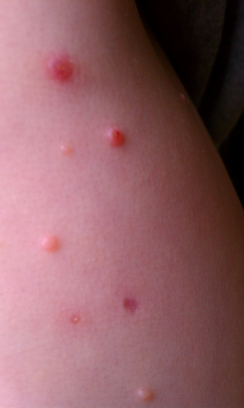Molluscum Contagiosum in a 4-Year-Old Girl
The mother of this 4-year-old girl was concerned that these lesions were sexually transmitted. The physician recognized them as molluscum, but was uncertain of the potential relationship of this rash to child abuse.

A 4-year-old girl presented to her primary care physician with these lesions that had been present for several weeks. The child’s mother was increasingly concerned that the lesions were not of an innocent nature. The first lesion had started on the anterior aspect of the child’s leg; new lesions were now spreading to the other leg and toward the groin. The mother was worried that these were sexually transmitted or abuse-related.
The mother had 2 other children and neither had any rash. The only variable between this child and her siblings was that she attended daycare.
The physician was certain of the cause of the rash, but uncertain of its relationship to child abuse.
Telephone consultation with local child abuse center provided the following reassuring information. This was a case of molluscum contagiosum, unrelated to abuse.
There were no allegations of abuse in this case. The interview provided no reason to suspect abuse and the social worker found no risk factors in the family for abuse.
After the social concerns were ruled out, the issue became a medical one. The diagnosis was molluscum contagiosum. The highest incidence of this very common viral skin infection occurs in children under 5 years old; however, the disorder is increasingly seen in sexually active teens and in immunodeficient individuals.1
Molluscum spreads through direct contact from playing, sports contact, fomites, sexual activity, and breast feeding.1,2 The incubation period is 2 to 7 weeks, but may be as long as 6 months. Common locations for the lesions are legs, abdomen, genitals, and eyes. Coitus is not a necessary precursor to genital infection, which can occur by self-inoculation if the lesions are present elsewhere on the body. If lesions are present only on the genitals, however, it is prudent to rule out abuse.1
Molluscum is self-limited; lesions generally resolve within 6 to 12 months. Nevertheless, multiple treatment regimens are available.1,3 Spread of the infection can be limited by covering lesions with clothing or a light bandage. Molluscum does not exclude the child from school or public swimming pools.2
In this patient’s case, once the family was reassured that the lesions were not the result of abuse, no treatment was sought. After checking at the daycare and with neighborhood friends, the family found other children with the same lesions.
As with many conditions, abuse needs to be considered in the differential diagnosis of molluscum just to be complete. A through history will eliminate many possible considerations.
References
1. Feigen RD, Cherry JD, Demmier GJ, Kaplan SL. Textbook of Pediatric Infectious Diseases. 5th ed. Philadelphia: Saunders; 2003:587;3347-3348.
2. American Academy of Pediatrics. Molluscum contagiosum. In: Pickering LK, Baker CJ, Kimberlin DW, Long SS, eds. Red Book: 2009 Report of the Committee on Infectious Diseases. 28th ed. Elk Grove Village, IL: American Academy of Pediatrics; 2009:466.
3. Silverberg NB. A practical approach to molluscum contagiosum. Contemp Pediatr. 2007;24:63-72.
Recognize & Refer: Hemangiomas in pediatrics
July 17th 2019Contemporary Pediatrics sits down exclusively with Sheila Fallon Friedlander, MD, a professor dermatology and pediatrics, to discuss the one key condition for which she believes community pediatricians should be especially aware-hemangiomas.